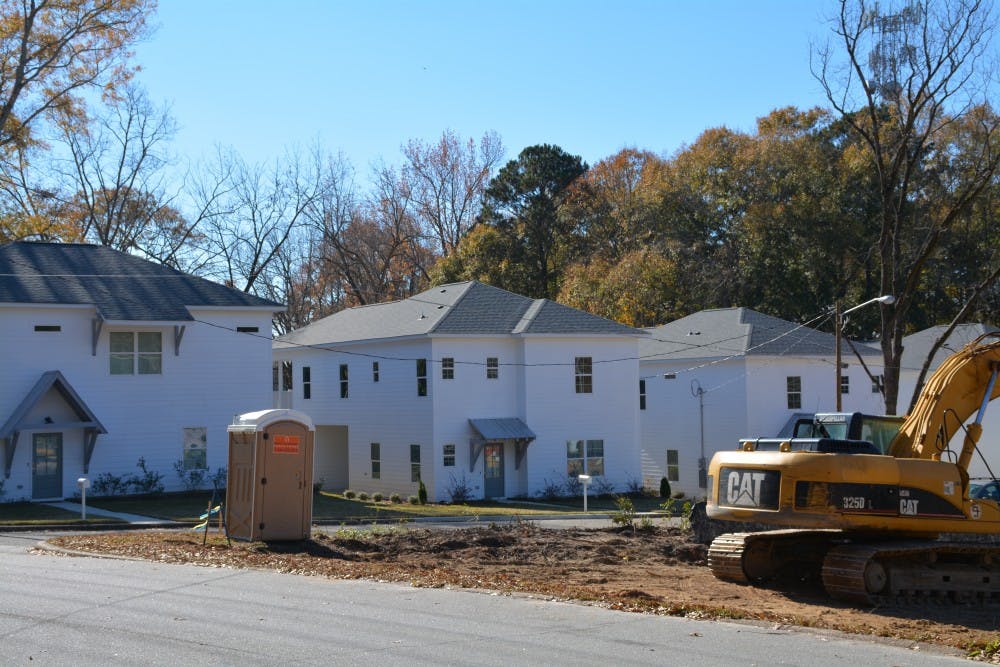I. ‘I don’t want to leave’
Veira Collins was born and raised in Auburn — across the tracks. The latter distinction is made, she says, because there is, and has always been, a disparity between these worlds. One side had paved roads in the ‘60s, air-conditioned buildings, a stadium; the other a red dirt road that led to the area’s sole, dilapidated high school and few struggling businesses — all on the other side, all sectioned off and left in shambles for people like Collins, whose black skin made her vulnerable to cruelty and discrimination in Auburn.
Her skin was a magnet for racism, she says. It was a part of her as she walked the hallways of Auburn High School in 1971 during its second year of integration. It followed her across the sidewalk when, on her way to the Auburn Bank, students whispered racial slurs in passing.
Sanctity would come, she recalls thinking, after owning some land. Her family had always rented when she was younger, and she promised herself she would buy a house one day with her own family. In 1983, Collins, with her husband and 6-year-old son, bought a pearl white home with deep blue trimming. The house is on Frazier Street.
“Whatever happened during the day didn’t matter no more when I got home,” Collins says. “Here, you know, it was a black community. We didn’t have much, but we had peace.”
Almost every home on Frazier, and on adjacent streets, was owned or rented by a black family, the elderly residents still living there say. And the families had nearby locales to visit. There was a theater at the end of the street, a barbershop, a café and a bar, all serving the community since Jim Crow, all black- owned. Collins tells of homes having beautiful gardens and yards being full of flowers. It’s a romantic memory, she admits, because this was her refuge from racism.
“We loved it here. The older people talked to you like you were their child, and there was no animosity,” Collins says.
Within her plot of land, her child could run around. Within this street, her husband could walk to the café unobstructed by hateful glares or murmurs.
“There was a togetherness that I — I just can’t forget. It was home. It was pleasant, and I —,” Collins says, before pausing to look around her street.
Her eyes begin to well. She’s jolted by the sound of a drill saw next door. Then, she pauses to hear the loud rattle of construction machinery. And the hammers ensue their thumping. And the bulldozers beep. And the workers in hard hats yell instructions. And the red dirt, which once marked this street, is flattened and smoothed for the new structures being built — structures forcing the low income, elderly folks, like Collins, to flee.
Collins looks away from the street and coughs, regaining her voice.
“Anyways, this was a neighborhood,” Collins says, her voice sounding as if it, too, were sanded and drilled. “And I don’t want to leave.”
II. FOR LEASE: Student Housing 5 BD 5BA
Frazier Street is located off Bragg Avenue, and its narrow road has recently been lined with pick-ups, white vans carrying tools and sawdust.
The cause for this crowd of vehicles lies in what’s being developed: The Meadows of Auburn. Residents have said this is student housing. The developer of The Meadows, Lagasse Construction, would argue they’re building single-family detached units on detached lots, which is true, technically.
And yet, Lagasse has a sign outside the lots that states: “FOR LEASE: Student Housing 5 BD 5 BA.” Their Instagram invites students to “a new development that offers off campus student housing.” Undoubtedly, and in the developers own Instagram slogan, this is student housing being built in a predominantly black and elderly community.
Felix Lagasse, owner of Lagasse Construction, declined multiple requests for comment, some in person.
Here’s how the hammers were permitted to thump.
On Oct. 25, 2016, residents of Frazier, plus many others from Northwest Auburn, attended a meeting for the Northwest Auburn Neighborhood Plan. The plan was intended to be a “roadmap for the future of northwest Auburn, developed by and for its residents,” as stated on the City of Auburn website.
Residents of Frazier now take offense at the city government claiming the plan was “developed by” residents.
“In the meeting, when they talked about the zoning, they were telling us what was going to be done,” Collins said
Collins said the meetings were “full of jargon.” This stance from residents, of the city not being inclusive and intentionally misleading, was a constant throughout the planning process. The only participation allowed from residents, Collins said, was drawing on a map with markers, like schoolchildren. That was “pointless,” she said, because nothing was ever really explained — especially the zoning and its implications.
Residents in the area wanted to be zoned neighborhood conservation. NC only allows single-family homes and only two unrelated people can live together. In other words, it’s explicitly for residents, not for students.
For years, Frazier Street was zoned as RDD, a redevelopment district, and it allowed up to five unrelated people to live together, meaning it was permissive for groups of students to live there. At the meeting, residents expressed their desire to maintain their quiet neighborhood and refrain from allowing students to come in.
Collins, along with other residents, saw on a PowerPoint how the proposed zoning changes from the Planning Commission replaced the RDD zoning on Frazier Street, as well as the NC zoning on Williams Avenue, with a new zoning termed: NRD, or neighborhood redevelopment district.
NRD is intentioned as “strictly residential,” according to the Planning Commission. But instead of helping prevent an influx of students with a regulation, as residents suggested, the Planning Commission made it so that developers of residential property could construct almost any type of housing, provided it was a single-family unit, without city approval.
The meetings went on for two years. The residents and the city went back and forth on the Northwest Auburn Neighborhood Plan. Collins told them what she wanted to see in the plan and prayed it would be heard and implemented.
In January, her prayer was answered — just not to her or her neighbors’ satisfaction. She saw someone had bought an empty lot on the corner of Frazier and Grant and was beginning construction. Slowly, the house began to take shape, and the skeleton of the building resembled a neighborhood home less and less each day.
She had to ask a worker.
“What’s being built here?” Collins asked. The worker told her. It was student housing. And he told her a lot more were about to be springing up. And he asked if that made her upset, she said.
She returned to her home. And the hammer thumped.
III. How the homes sprung
The Meadows of Auburn built a closet for each room and made the home detached from other lots. The owner cleverly capitalized on the RDD zoning, which was still in place in January, to build their supposed single-family homes.
But a zoning change didn’t lead to the student dwellings being built.
RDD classified a residential home as a single detached unit on a single detached lot. The Meadows fits these criteria, so the city had to define these structures as single-family homes. But the city also had some time to consider what was happening and fix it in the Northwest Auburn plan.
These homes first sprung up in January of this year, and their construction was at a rapid pace. The Northwest Auburn Neighborhood Plan’s zoning proposals hadn’t been approved yet. Collins and her neighbors voiced their concern to the Planning Commission and to the City Council, hoping to halt the potential construction of more student homes in their neighborhood and hoping their concerns would be considered and addressed with regulations or alternate zonings in the plan set for approval later that year.
They expressed. They waited. On June 27, 2018, The Northwest Auburn Neighborhood Plan was approved, along with the new zoning ordinances, which did not address the student homes being built. It was too late. The plea from the black residents on Frazier Street went ignored by the Planning Commission and the City Council that approved this plan. Four more student houses went under construction around that time.
Planning Commission Director Forest Cotten said they did consider making the area around Frazier a neighborhood conservation zone, but that they needed to take everyone into account.
“We initially tried to restrict [Frazier Street] to the family definition, but we got a lot of backlash from a lot of the property owners,” Cotten said. “You have a lot of people that already have investments in this property area, for example, in Breckinridge.”
Breckinridge is a cul-de-sac neighborhood to the east of Frazier Street. The homes cost about $250,000, according to multiple online real estate websites, and are rented to students.
Collins said she wonders if the priorities of “wealthy property owners” were placed above that of the black community who expressed, and are expressing, an equal amount of backlash. The Breckinridge properties are on the east side of Frazier, local residential homes are to the west and a few were already neighborhood conservation.
Collins said she doesn’t understand why conservation was not only not expanded, but stripped away, like on Williams Avenue.
The student dwellings are already causing residents to stay up at night — not just from parties, but from fear.
Theresia Singleton lives on Talbert Drive, adjacent to Frazier. There are two student homes being built directly in front of her home. She worries her landlord will increase her rent because of rising property taxes caused by The Meadows affecting property values in the neighborhood.
“Sometimes it keeps me up at night, you know, thinking I won’t be able to afford living here next year,” Singleton said. “That’s what’s happening, though. They’re forcing black people out — one way or another.”
Jeff Williams lives down the road from Singleton, also on Talbert Drive. His expression when talking about the student homes is one of stone. Every week, he receives mail from people and companies wanting to buy his home, he said.
“It’s frustrating. We don’t like what’s happening, but what can we do? I’m sure our time’s coming, too,” Williams said, referring to the very real possibility of having to move out of the area.
Residents’ sentiment toward the student housing is clear: The developers of these homes are inconsiderate, and the city has been lackluster in their efforts to put an end on this invasion of their neighborhood.
And Collins, who once felt protected and tranquil in her home, will now be living beside a student house, sandwiched between her home and her 80-year-old neighbor.
IV. 'We were disrespected'
This phenomenon of students and universities encroaching neighborhoods is not singular to Auburn.
In College Station, Texas, the home of Texas A&M, residential neighborhoods were seeing "shadow dorms" being built by developers. The student homes, referred to as AgShacks, didn’t match the architecture of the other houses. It caused discomfort in the area with increased traffic and clashes between residents and students because of parties and noise complaints.
The same is happening in Auburn.
While the student house next to Collins hasn’t been built yet, four others are already nearby. That’s 20 students. On weekends, she’s already been blocked out of her driveway from other vehicles, and the narrow road has almost caused several accidents with the increased traffic. Eight more homes are being built and finished for next semester. That’s a total of 60 students. This will only get worse for residents, she said.
“I do believe, inside, that this was allowed because this is just a black neighborhood – and we were disrespected, you understand? Disrespected,” Collins said. “This was a community. Now, look around.”
Encroachment is nothing new. At 319 Bragg, where there’s currently student apartments, there was a trailer park called Heritage Park. According to residents on Frazier Street and people familiar with Northwest Auburn, the trailer park was almost entirely inhabited by black people. In 2008, the owner of the park sold the property, and residents had to find a new place to live because apartments for students were coming in.
Collins, Singleton, Williams — they’re all familiar with this tale. When students first moved in, they gave these new structures the benefit of the doubt. They had hope, but when one is born a person of color in Auburn, Collins explained, this hope, that the worst will not come, that displacement will not occur, that perhaps one will be allowed to live comfortably in their home as an old woman, after scrubbing the homes of white people — this hope is crushed and buried and replaced with tall, looming structures, reminding them how utterly wrong they were to believe such things.
V. FOR SALE BY OWNER
Dell Brooks has the aura of a philosophy professor. He worked as a truck driver all his life, always on the road, always coming back, in roundabout ways, through streets and highways, home. With his calloused, black hands, he built his home. Built it in 1999, he likes to say proudly. It sits on Williams Avenue, painted beige with olive trimming. It used to be zoned neighborhood conservation. That’s changed.
Directly next to his lot of land, on Canton Avenue, is a wreckage of slashed trees and bulldozers. The cause of this construction derives from Canton Farms LLC, a developing company based out of Atlanta, according to court records. Canton Farms bought the 1.3 acres next to Brooks’ home on Sept. 21, 2018, but actual construction has just begun. Canton Farms declined a request for comment.
“When they’re done building this, and the students come in, it’s going to overflood the neighborhood,” Brooks said.
He must sell, he said. He doesn’t want to drown.
“I’m not comfortable here anymore. … I love my house, I love my home, but I can’t spend my retirement reminding people to not park in front of my house and leave beer cans on my yard,” Brooks said. “Deep down, I don’t want to leave. I built this house.”
Twice, already, his mailbox has been pummeled by a drunk driver coming from a party in one of the student homes, he said. His grandkids visit him often, and he doesn’t want them hurt.
As to why he thinks his home got removed from neighborhood conservation, he said there’s not much to decode.
“They won’t remove neighborhood conservation zoning in white neighborhoods,” Brooks said. “And what the hell do the developers and city care? It’s not their neighborhood being destroyed.”
His family was born in Auburn. He was raised here. This is his home. The student houses are forcing him to flee, he said. On Nov. 6, when the ground was getting cleared for Canton Farms, Brooks stuck out his “FOR SALE BY OWNER” sign.
“They strong-armed this black neighborhood out of their land and forced them out,” Brooks said. “And now, I have to move out of Auburn. … It’s not right, but me and my wife have to get out of here.”
Displacement is now a reality.
VI. The Gentrified
Carla J. Bell is the dean of the Robert Taylor School of Architecture and Construction Science and Management at Tuskegee University. She’s studied what’s happened on Frazier. This, she said emphatically, is gentrification.
Gentrification was coined by British sociologist Ruth Glass in 1964. It occurs, he states, when residents like Brooks, “are displaced, and the whole social character” of the neighborhood “is changed.”
The displacement often happens to low-income residents, which has historically meant people of color.
Bell was a professor in the College of Architecture, Design and Construction at Auburn University. She taught in the master of community planning program.
At both universities, Bell researched gentrification and discussed the psychological and social issues relating to the built environment and the effect of architecture on human behavior.
“On the topic of gentrification and what I believe is happening on Frazier Street, my response is absolutely yes,” Bell said. “The current residents living on Frazier Street are moving out of their neighborhood and, in some cases, are being forced out because of the demographic change in the neighborhood.”
Ward 1 Councilwoman Connie Smith Taylor agreed with Bell’s sentiments. She said she understands the disparity these student houses have caused because she lives at the heart of it. Her home is on Williams Avenue. She’s lived there for 20 years.
Taylor’s home is right behind Brooks, who is selling. Her other neighbor, who is 80 years old, is considering selling. If a developer buys both properties, she said, that will force her to sell, lest she be bordered by the very structures corroding her community.
“Everybody’s going to be gone, so it’s going to not only force my neighbors out of the neighborhood; it’s going to force me out,” Taylor said. “That’s my ward. That’s how I made City Council. Where am I going to go and stay in my ward?”
There was a silence in the room before she continued.
“And another thing: I’m on the City Council, living in my neighborhood, about to be forced out of my neighborhood. I have a really big problem with that,” Taylor said.
Taylor said the developers should have had more sympathy toward the neighborhood when constructing the homes. It was pure greed, she said, that made Lagasse Construction and Canton Farms build here.
“It’s just a label — developer. But they’re people. They’re human,” Taylor said. “And all they want to do is make the dollars. It’s all about the dollars. You’re not considerate of the well-being of people — you’re only considerate of money.”
The Planning Commission said they are aware these homes are causing stress for longtime residents.
“We have identified this as an issue that we need to appropriately address. I think we’re responding as quickly as our process allows us to respond,” Cotten said. “It’s a community plan. You have to allow people to respond to your proposal, whether it be the development community, the neighborhoods.”
He added that they’re currently drafting a “zoning regulation amendment” that “would create a new use type” he’s coined as “academic detached dwelling unit.”
When Brooks, who had just readjusted his for sale sign, was told this, he smirked mockingly.
“Well, tell Cotten that this ‘amendment’ is a little too late for us,” Brooks said.
Collins echoed this sentiment.
“That might help other neighborhoods now, but this black community’s being cheated as far as I’m concerned,” Collins said. “And I suppose it’s the white neighborhood that’s going to benefit from our experiment, right?”
As she spoke, the hammers thumped and thumped and thumped.
“They all get to walk out in their neighborhoods, drink their coffee, looking like grown folk, looking at grown folks,” Collins said. “On this side of the tracks, we got to come outside and look at teenagers. We’re nothing. We’re counted as nothing.”
Do you like this story? The Plainsman doesn't accept money from tuition or student fees, and we don't charge a subscription fee. But you can donate to support The Plainsman.




